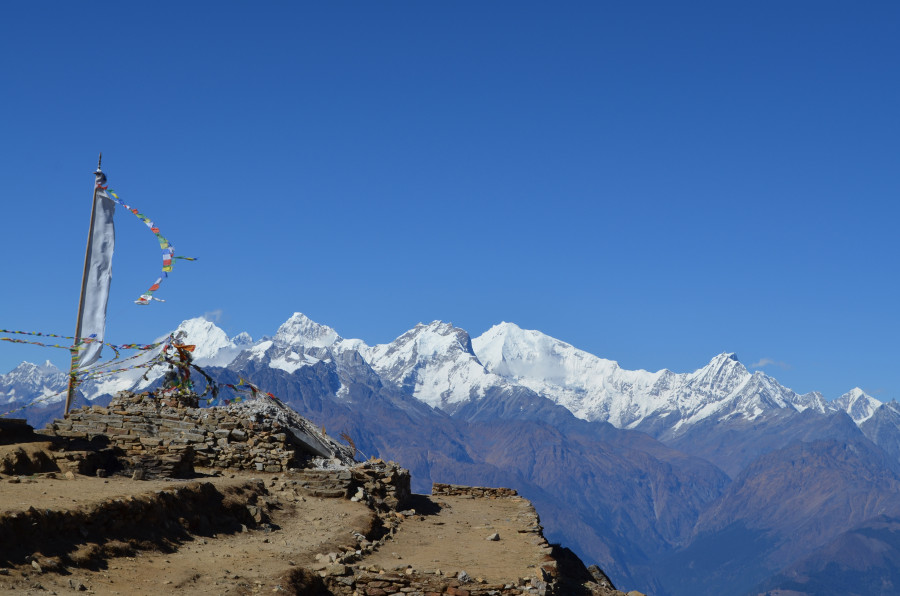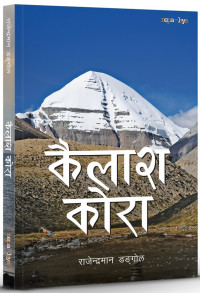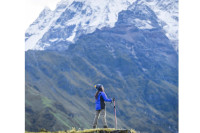Travel
Gosaikunda: More than just the lake
An end-of-season-trek to the holy waters of the lake brings about harsh winds, cold nights, but also arresting views.
Gina Bachmann
Wrapped in six layers of shirts, jumpers and jackets, sweaty and slightly shivering, holding a cup of milk tea in my hands, I let my gaze wander across lake Gosaikunda—the destination I had walked to, for the last two and a half days. The lake is of a dark, intense blue colour, lying still in its basin of grey rocks. Despite the winds, there are no waves, just a few small curls on the shores. The sky is lighter in colour than the lake but is just as flawless, without any clouds at all. I take a deep breath.
When I planned this trip about a month ago, I was unsure if I would even make it to the lake. I took it as a trial for me, because I had never been on such high altitudes, and I was afraid I might get altitude sickness. Reinforcing my doubts was the timing of the trek—it was already the end of November, many had warned me that the temperature might drop below zero degrees at night. So, standing at the shore of this lake, at 4,400 metres above sea level, was a great feeling.
Retrospectively, however, it’s funny how reaching the top seems secondary. A hike is not a mission, it’s a journey. And it’s journeys that have the potential to challenge and surprise us, not destinations. Hence, apart from the lake, there are many reasons why it is worth climbing to Gosaikunda.
Situated in the Langtang National Park, Gosaikunda is an important pilgrimage site for Hindus. Lord Shiva is believed to have created the lake by punching a hole into the rocky landscape because he was desperate to satisfy his thirst after having been poisoned. Gosaikunda is also popular with trekkers because of its close proximity to Kathmandu, yet offer a very mountainous experience. I had booked a guide to accompany me, which is recommendable for solo travellers, who are not used to walking in high altitudes and don’t know the area.
As most people do, we started the trek from Dhunche, which is a seven-hour drive from Kathmandu. We arrived in Dhunche on the back of a jeep. Feeling a bit creased and dusty, we got off the jeep and went to a hotel. I was happy to discover that there was hot water and went for a shower—the last one for the next four days.
From Dhunche, the path first leads downwards for a while, to the Dhunche river. The path was littered with dry leaves and corns, which produced a cracking sound while we were walking. Following the river upstream, you eventually have to cross it and the path gets steeper. As I hadn’t been doing much physical activity for some time, the climb proved tough. We took three short breaks before we reached Deurali at around 10:30 am. At Deurali, we stopped for lunch break. We had to wait for our dal-bhat for about half an hour but I didn’t mind at all. I was happy to relax for a while and take a closer look at the surroundings. We were at a small tree-less plateau surrounded by the forest. The lodge was home to a family. Near the lodge was an old man ploughing a dry patch of land with his oxen, driving them while making funny sounds. Two kids of around two years were toddling around, their identical clothes were hanging stiffly on a washing line behind the house. The sky was grey and the peaks of the mountains in front of us were blanketed with white clouds, some of which looked like shreds of cotton wool. Looking to the southeast, I could see the valley of the Dhunche River from where we had come from. The dense forest mostly consisted of a mix of conifers and sal trees. On the way, my guide had spotted two langur monkeys brachiating through the thicket.
Finally, the dal-bhat arrived. I was hungry and tucked in on the huge amount of rice the lady had served me. Right after lunch, we continued the trek but with my rice-filled stomach, the walk proved difficult. We had to climb about 700 metres to Chandanbari, our destination for the night. The path relentlessly climbed upwards again. When, after around two hours, we reached the quaint village consisting of a few lodges, a monastery and a cheese factory, I felt fine. But after a while, I got a massive headache. Chandanbari lies at 3,300 metres above sea and I was worried whether I would get any other symptoms of altitude sickness. I started drinking litres of hot water but it didn’t get any better. A short visit to the monastery and the cheese factory—both of which turned out to be closed—didn’t lift my spirits either. I was cold and extremely sleepy, and figured that only an early night would restore my energy.
%20lead%20edited.jpg)
Luckily, the next day, my headache was gone and I felt motivated to tackle the next leg—from Chandanbari to Laurebina. First, we walked through a forest of giant conifers. In between the dark, tall trunks, we managed to catch a brief glimpse of the snow-capped mountains of the Langtang Valley. After the stair-like path had led us out of the forest, we reached a sandy plateau from where we could see Langtang Lirung in its full majesty. We stopped there for lunch and I treated myself with a short nap on a bench inside the lodge. The sun was shining through the window, warming my face.
As we continued walking, we crossed the tree line and the landscape changed to a desert-like, rocky wasteland, with dry, knee-length bushes. The higher we walked, the sparser the landscape got. The combination of the steep ascent and the low air pressure made me take heavy breaths. We had to walk slowly and take many breaks. We stopped at a Hindu shrine. Due to the lack of trees, I felt we were more exposed to the wind. The prayer flags were fluttering fast and produced a metallic noise when they banged against the pole. In the distance, I could hear the wind rushing through the forests of the Dhunche River valley.
At around 2:30pm we reached Laurebina. Our lodge was built with stones and had a more alpine touch than the previous ones, all of which had a kind of a backpackers feel with Bob Marley posters and flags of different countries. But the one in Laurebina was scarcely decorated. It was much colder as well. The water in the buckets for flushing the toilet was frozen and white clouds of breath emerged out of my mouth when I yawned. When the sun was about to set, almost everybody left their warm place around the fire in the dining room and went outside to watch the sky perform its dramatic transformation from blue to black. Maybe it’s because of the lack of oxygen that I started to have these funny thoughts. Seeing people marvelling at the red stripe on the horizon, they seemed to me as if they were paying tribute to the sun, which had warmed them all day long. Maybe the reason why sunsets never fail to amaze us human beings is that there is a distant, subconscious, infantile fear that we can’t be sure whether the sun will return the next day. Why else would there always be such an awe-stricken silence when we watch a sunset, I wondered.
Shortly after the spectacle, dinner was served and the fire slowly died out. The only warm place left was one’s sleeping bag. Thus, like everybody else, I turned in at around 8pm and passed out immediately.
The good news: the sun did return the next morning. It brought about a bright and clear day. The bad news: well, there wasn’t any. The last few kilometres before Gosaikunda was one of the most scenic walks I ever had the chance to take. With the Annapurna range, Manaslu, Ganesh Himal, the peaks of Tibet and the Langtang Valley at our backs, we slowly climbed the last few hundred metres of difference in altitude. Eventually, the path flattened out, which led us around a rock that opened up the view of a steep, rocky slope. The sandy path was draped like a light brown cord from where we stood, guiding us to our destination. The walking became much easier and I started wondering what the lake would look like.




 8.12°C Kathmandu
8.12°C Kathmandu










